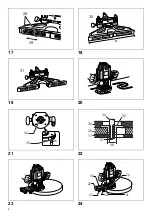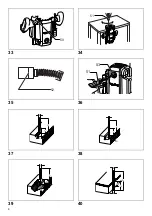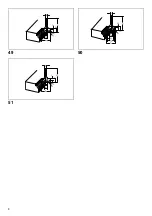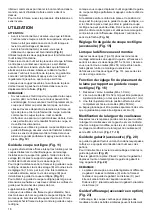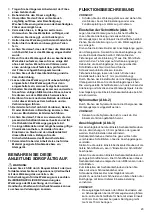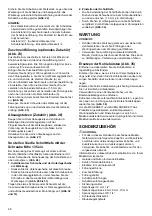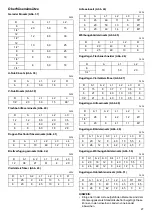
12
Wider straight guide of desired dimensions may be made
by using the convenient holes in the guide to bolt on extra
pieces of wood.
(Fig. 13)
When using a large diameter bit, attach pieces of wood to
the straight guide which have a thickness of more than 15
mm to prevent the bit from striking the straight guide.
When cutting, move the tool with the straight guide flush
with the side of the workpiece.
If the distance between the side of the workpiece and the
cutting position is too wide for the straight guide, or if the
side of the workpiece is not straight, the straight guide
cannot be used. In this case, firmly clamp a straight board
to the workpiece and use it as a guide against the trimmer
base. Feed the tool in the direction of the arrow.
(Fig. 14)
Fine Adjusting Straight Guide (accessory)
(Fig. 15)
When Router is Mounted
Insert the two rods (Rod 10) into the outer mounting slots
of the guide holder, and secure them by tightening the two
clamping screws (M15 x 14 mm). Check to make sure that
the thumb nut (M6 x 50 mm) is tightened down, and then
slide the router’s base mounting unit onto the two rods
(Rod 10), and tighten the base’s clamping screws.
Fine Adjusting Function for Positioning
Blade in Relation to Straight Guide
(Fig. 16)
1. Loosen thumb nut (M6 x 50 mm).
2. Thumb nut (M10 x 52 mm) can be turned to adjust
position (one turn adjusts the position by 1 mm).
3. After completing position adjustment, tighten thumb
nut (M6 x 50 mm) until secure.
Scale ring can be rotated separately, so scale unit can be
aligned to zero (0).
Guide Shoe Width Alteration
Loosen the screws marked by the circles to alter the width
of the guide shoe in the left and right directions.
After altering width, tighten the screws until they are
secure. Guide shoe width (d) alteration range is 280 mm
to 350 mm.
(Fig. 17 - 19)
Templet guide (optional accessory)
(Fig. 20)
The templet guide provides a sleeve through which the bit
passes, allowing use of the tool with templet patterns.
To install the templet guide, pull the lock plate lever and
insert the templet guide.
(Fig. 21)
Secure the templet to the workpiece. Place the tool on the
templet and move the tool with the templet guide sliding
along the side of the templet.
(Fig. 22)
NOTE:
• The workpiece will be cut a slightly different size from
the templet. Allow for the distance (X) between the bit
and the outside of the templet guide. The distance (X)
can be calculated by using the following equation:
Distance (X) = (outside diameter of the templet guide -
bit diameter) / 2
Trimmer guide (optional accessory)
(Fig. 23)
Trimming, curved cuts in veneers for furniture and the like
can be done easily with the trimmer guide. The guide
roller rides the curve and assures a fine cut.
Install the trimmer guide on the guide holder with the
clamping screw (B). Insert the guide holder into the holes
in the tool base and tighten the clamping screw (A).
To adjust the distance between the bit and the trimmer
guide, loosen the clamping screw (B) and turn the fine
adjusting screw (1.5 mm per turn). When adjusting the
guide roller up or down, loosen the clamping screw (C).
After adjusting, tighten all the clamping screws securely.
(Fig. 24)
When cutting, move the tool with the guide roller riding the
side of the workpiece.
(Fig. 25)
Dust nozzle set (Accessory) (Fig. 26)
Use the dust nozzle for dust extraction. Install the dust
nozzle on the tool base using the thumb screw so that
protrusion on the dust nozzle fit to the notch in the tool
base.
Then connect a vacuum cleaner to the dust nozzle.
(Fig. 27)
How to use screw M6 x 135 for adjusting
the depth of cut
When using the tool with a router table available in the
market, using this screw allows an operator to obtain a
small amount of adjustment of the depth of cut from above
the table.
(Fig. 28)
1. Installing the screw and washer on the tool
• Attach flat washer onto this screw.
• Insert this screw through a screw hole in the tool base
and then screw in the threaded part in the motor
bracket of the tool.
(Fig. 29 - 31)
At this time, apply some grease or lubricating oil to the
inside of the screw hole in the tool base and the threaded
part in the motor bracket.
(Fig. 32 & 33)
2. Adjusting the depth of cut
• A small amount of depth of cut can be obtained by
turning this screw with a screwdriver from above the
table. (1.0 mm per a full turn)
• Turning it clockwise makes the depth of cut greater and
turning it counterclockwise smaller.
(Fig. 34)
MAINTENANCE
CAUTION:
• Always be sure that the tool is switched off and
unplugged before attempting to perform inspection or
maintenance.
• Never use gasoline, benzine, thinner, alcohol or the
like. Discoloration, deformation or cracks may result.
Replacing carbon brushes (Fig. 35)
Remove and check the carbon brushes regularly.
Replace when they wear down to the limit mark. Keep the
carbon brushes clean and free to slip in the holders.
Both carbon brushes should be replaced at the same
time. Use only identical carbon brushes.
Use a screwdriver to remove the brush holder caps.
Summary of Contents for RP1800F
Page 2: ...2 1 2 3 4 5 6 7 8 1 2 3 4 5 6 7 8 9 8 10 6 11 12 13 14 15 16 ...
Page 3: ...3 9 10 11 12 13 14 15 16 17 18 19 20 20 18 20 18 17 21 21 22 23 24 25 26 21 55 mm 55 mm 27 22 ...
Page 4: ...4 17 18 19 20 21 22 23 24 28 29 30 d 31 32 33 34 35 36 17 37 38 32 39 22 23 40 41 24 ...
Page 5: ...5 25 26 27 28 29 30 31 32 17 34 42 44 43 45 46 45 46 47 46 48 49 ...
Page 6: ...6 33 34 35 36 37 38 39 40 50 51 52 53 51 R ...
Page 7: ...7 41 42 43 44 45 46 47 48 ...
Page 8: ...8 49 50 51 ...




